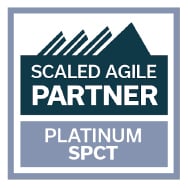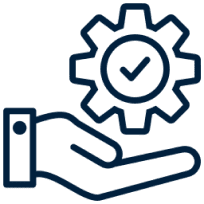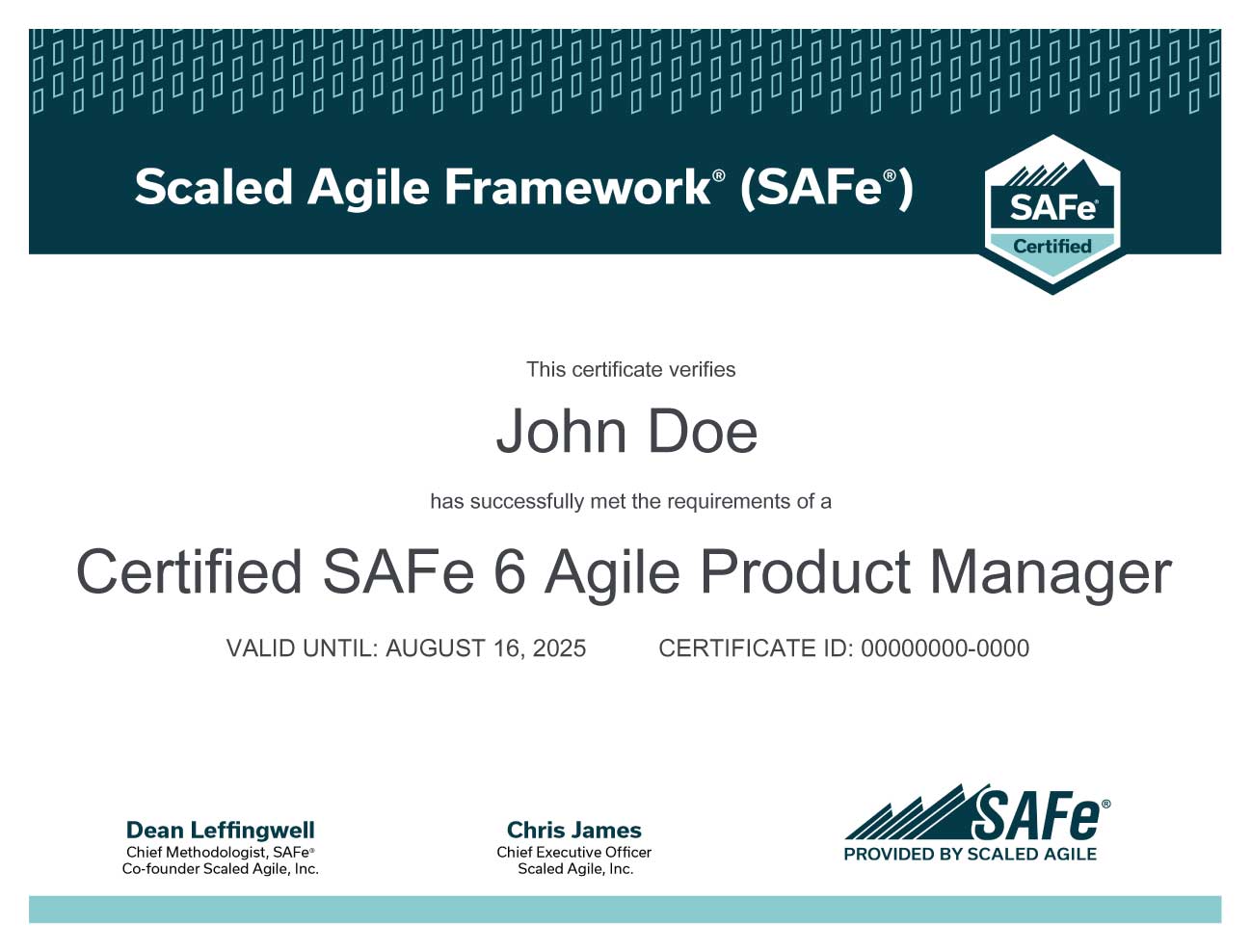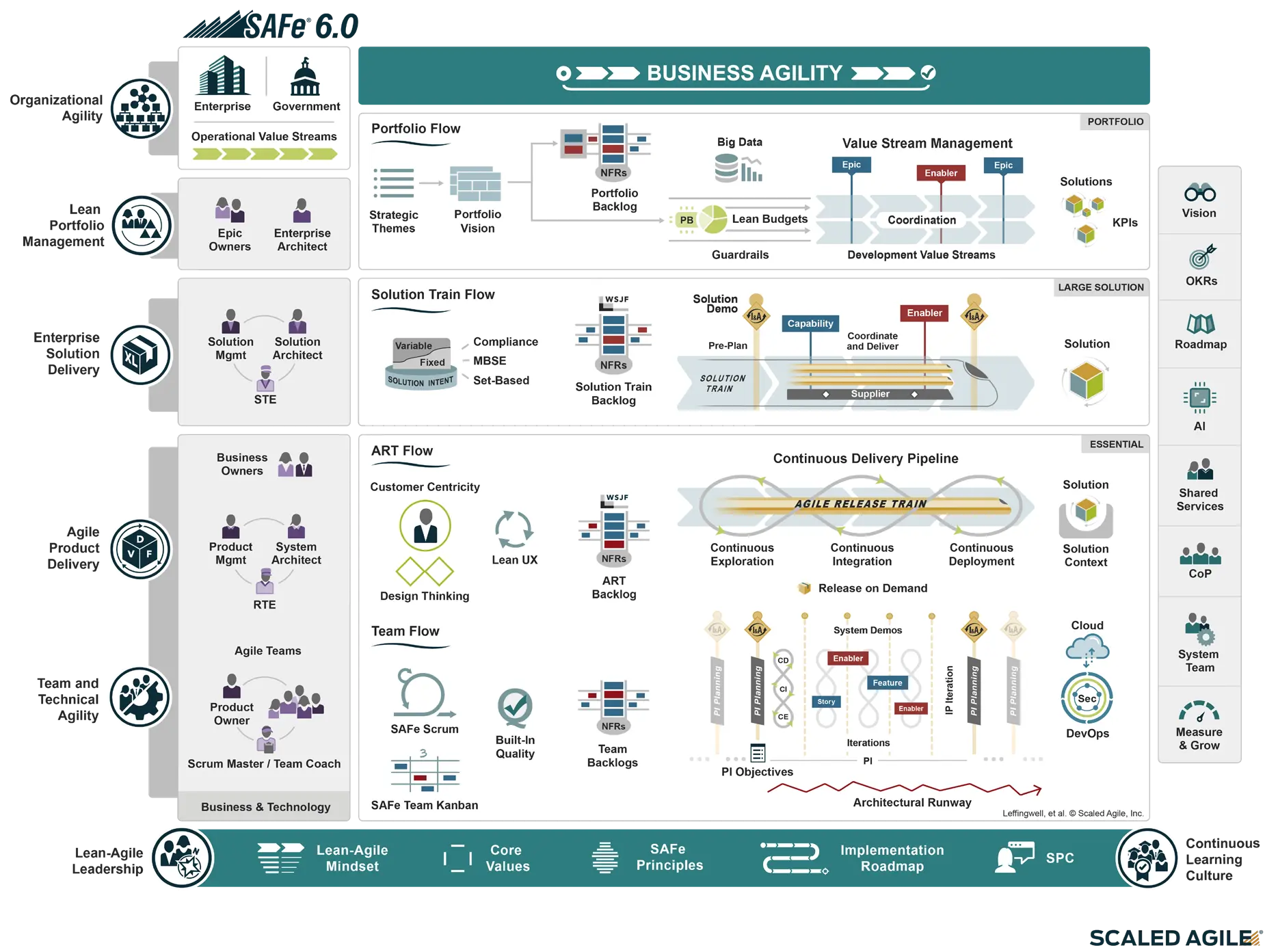

Scaled Agile Platinum SPCT Partner
SAFe® 6.0 Agile Product Management (APM) Certification Training
SAFe APM: SAFe® 6.0 Agile Product Management Certification Training
Lead Agile Innovation & Design Thinking with SAFe® Agile Product Management Certification
2K+ Enrolled
Accredited by


Accredited by


Scaled Agile Platinum SPCT Partner
SAFe® 6.0 Agile Product Management (APM) Certification Training

5.0
2K+ Enrolled
Lead Agile Innovation & Design Thinking with SAFe® Agile Product Management Certification
Accredited by



Guaranteed to Run Workshops

Expert-Led Study Sessions

Networking Opportunities

Flexible Monthly Payment Plans

Real-World Case Studies

Hands-On Project Experience
Request More Details
450K+
Professionals trained
250+
Workshops every month
30+
Trainers
450K+
Professionals trained
250+
Workshops every month
20+
Trainers
Course Overview
SAFe Agile Product Management (SAFe® APM) Certification Training provides an extensive understanding of Agile Product Management principles and practices. This Agile Product Management course covers the entire product lifecycle, from developing strategies and roadmaps to executing effective product marketing.
Learn how to leverage design thinking, data-driven market research, and product strategies to prioritize customer needs and drive innovation throughout development. Simpliaxis facilitates this learning journey with expert trainers and comprehensive resources. Through interactive online sessions, real-world case studies, and practical exercises our SAFe APM certification training ensures participants grasp the key concepts and strategies of Agile Product Management.
Additionally, Simpliaxis offers guidance and support to prepare for theSAFe® APM certification exam, entitling individuals to exhibit their proficiency and earn recognition as certified Agile Product Managers. At Simpliaxis, participants are equipped to clear the SAFe® APM certification and drive successful outcomes in SAFe Product Managers Roles.

SAFe APM Training Highlights
24-hour interactive online session
Earn 24 PDUs and SEUs
Course workbook and SAFe Studio access
Hands-on Practical experience
Access to SAFe Community Portal
Exam Fee Included in the training cost
Comprehensive Exam Support
100% Success Rate
Learn from Platinum SPCT Partner of Scaled Agile
Access to content, resources and tools required to practice SAFe every day

Career upliftment


Unsure about your prep?

Benefits focused on Individuals and corporate
Common attendees
Agile Coaches / Consultants / Agile Trainers
Product Managers
Product Owners
Business Owners / Business Analysts
Product Marketing Managers
Product Management Teams
UX Professionals
Customer Experience Professionals
Project Managers
Solution Managers

Prerequisites for SAFe APM certification training
The SAFe® APM certification training doesn’t have strict eligibility requirements, but strong recommendations are in place to set you up for success:
Exam Format

_1733299379.jpg)
Complete Training:
Enroll for the SAFe 6.0 APM course with Simpliaxis. Participate in a 24-hour live sessions and successfully finish the training.
Study & Practice:
Utilize the course materials, articles, guides, and resources from the professional Training expert to prepare for the Exam.
Take the Exam:
Clear the 2-hour SAFe APM Certification exam with 75% passing marks.
Become Certified:
Earn your SAFe® Agile Product Manager badge from Scaled Agile Inc.

Get the SAFe APM Certification

Curriculum
Course Curriculum
What you will learn in this SAFe APM workshop
Design Thinking for Product Success:
You will learn a human-centered approach to developing products that people actually want. Imagine brainstorming solutions by considering what's desirable (for customers), feasible (what you can actually build), and sustainable (good for the business).
Understanding Customer Needs:
This identifies your customers, their problems, and how your product can solve them. You will learn to target the right audience and address their needs.
Market Dynamics and Strategy:
This topic equips you to analyze the competitive landscape, understand market trends, and develop a winning product strategy. Imagine it like figuring out the playing field, who your competitors are, and how your product will outperform them.
Value Stream Economics:
You will learn how to manage the financial side of your product's development, including pricing, budgeting, and cost analysis. This is like understanding how much it costs to develop your product and how to price it competitively.
Building Empathy for Better Products:
This focuses on deeply understanding your customers' needs and emotions. Imagine putting yourself in their shoes to design a product that resonates with them.
Crafting a Product Vision and Roadmap:
Here, you will learn how to define a clear vision for your product, outlining its long-term goals. You will also develop a roadmap that breaks down the steps to achieve that vision. This is like having a clear picture of what you want to accomplish with your product and a plan to get there.
Executing with SAFe® Agility:
This dives into how SAFe® principles can be applied to manage product development in a fast-paced, adaptable way. Imagine having a flexible approach to product development that allows you to adjust to changes and deliver value quickly.
Driving Innovation in the Product Life Cycle:
You will explore how to continuously improve your product and introduce new features throughout its development. This is like keeping your product fresh and exciting for customers by constantly innovating.

40+ Certification programs made an impact
Employee retention improved by 45%
Work satisfaction and capabilities improved by 30% on an average
100+
Clients













SAFe APM Certification Course For Corporates
With learning targeted to your unique team environment, we at SimpliAxis help to resolve your specific issues and meet your specific needs with tailored training methods. We offer corporate training globally to keep Organizations up to date by building the knowledge gap required and make them strive in the competitive world with the right skills according to the industry needs.

Our Customer words for us
SAFe Big Picture
- Achieving Business Agility with the Scaled Agile Framework (SAFe)

Meet the Team That's Invested in Your Success
What is SAFe Agile Product Management (APM) course about?
What does the Simpliaxis’ SAFe® Agile Product Management (APM) course cover?
What are the Prerequisites for the SAFe Agile Product Management course?
How long is the SAFe APM certification valid and how do I renew it?
How is the SAFe APM course delivered at Simpliaxis?
How the SAFe APM program helps in achieving professional growth?
What are the career benefits of earning SAFe APM certification?
Who should enroll in the SAFe 6.0 APM training?
Will I receive any SAFe community membership along with the training?
How many PDUs and SEUs will I be eligible for?
Where can I find the link to take the SAFe APM exam?
How long does it take to complete SAFe® APM training and certification?
Which role can I get after SAFe® APM certification?
How SAFe 6.0 APM certification will help me in the organization?
Is the exam fee included in the APM course?
What is the format of the SAFe APM exam and passing score?
How can I prepare for the SAFe APM certification exam after training?
What if I fail the SAFe APM exam in the first attempt?
What is the retake policy for the SAFe Agile Product Management exam?
Is there a preferred currency for payment, especially for international students?
Can payments be made online through your website, or do I need to visit a physical location?
Do you offer any discounts or promotions for early payment?
Can I pay for the course in installments, or is full payment required upfront?
Will I get a refund if I cancel my enrollment?
Where will I get my payment receipt?
Is there any transaction or processing fee?
What cards do you accept?
What payment options are available?
What if I miss a class? Are there any money back options?
If I want to know more about Training, whom should I connect with?
Is there any option to complete the Training in the native language if a participant chooses to?
Can I receive personalized Training at my convenience?
Where do I find the upcoming schedules of my course?
After enrollment, can I change the date of my training class?
Do I get any certificate upon completion of the course?
How do I enroll in the training course?
What are the different courses offered by Simpliaxis?
What are the different modes of Training available for Simpliaxis courses?
Do you offer online Training?
Do you offer corporate Training?
Who are the instructors of my course?
Is there any discount available for the Simpliaxis courses?
Whom do I contact if I have more queries regarding my course?
Are your courses affordable?
Why should I choose Simpliaxis?
What is the object of Simpliaxis?
How much discount will I get if I enroll for the Training?
SAFe APM Course FAQs
You will receive a defined methodology and an understanding of how to become a Product Manager through the SAFe® APM training. This course covers subjects including what the roles of a product owner and manager are, what customer centricity is, what the design thinking principles are, how product managers create market segments, various market exploration tactics, and more.
To ensure that students may benefit from the course, it progresses extremely sequentially. You can perform a gap analysis of your knowledge and abilities using the SAFe® APM programme to identify the most important areas in which you require improvement. Additionally, the course includes a variety of simulations, case studies, and examples so that you can quickly understand the ideas and develop future abilities.
SAFe® APM certification equips you for senior roles like:
You can reach out to our experienced career counselor
or email us on support@simpliaxis.com
or contact any of our phone numbers
or you can chat with us anytime
or visit our contact us page https://www.simpliaxis.com/contact-us
Find out why 1,000+ professionals love SimpliAxis